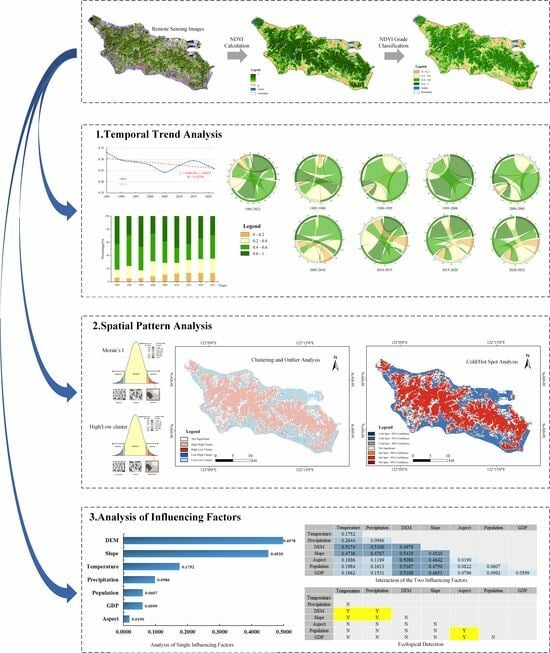Analysis of the Spatiotemporal Characteristics and Influencing Factors of the NDVI Based on the GEE Cloud Platform and Landsat Images
Abstract
:1. Introduction
2. Materials
2.1. Study Area
2.2. Data
3. Methods
3.1. Data Acquisition and Preprocessing
3.2. Drawing the NDVI Spatiotemporal Distribution Map
3.3. Spatiotemporal Pattern Analysis
3.3.1. Time Trend Analysis
3.3.2. Spatial Pattern Analysis
3.4. Analysis of the Influencing Factors
4. Results and Analysis
4.1. Drawing NDVI Spatiotemporal Distribution Maps
4.2. Temporal Trend Analysis
4.3. Spatial Pattern Analysis
4.4. Analysis of the Influencing Factors
5. Discussion
5.1. Accuracy of the Results
5.2. Uncertainty of the Results
6. Conclusions
- (1)
- Based on the GEE cloud platform and Landsat long-term sequence images, a 30 m resolution NDVI spatiotemporal distribution map of Zhoushan Island in nine time phases from 1985 to 2022 was drawn.
- (2)
- The vegetation coverage on Zhoushan Island showed a sparse trend. The average NDVI value dropped from 0.53 in 1985 to 0.46 in 2022, the low vegetation area increased from 28.84 km2 in 1985 to 67.29 km2 in 2022, and the extremely high vegetation area decreased from 197.96 km2 in 1985 to 146.32 km2 in 2022.
- (3)
- There was an obvious spatial high value agglomeration phenomenon in the NDVI on Zhoushan Island. The low-low NDVI clusters and significant cold spots were mainly concentrated in the coastal area of Zhoushan Island, and the high-high NDVI clusters and significant hot spots were mainly concentrated in the inner area of the island.
- (4)
- The analysis results combined with the geodetector showed that natural factors (e.g., DEM, slope, and temperature) played a positive role in the spatial distribution of the NDVI on Zhoushan Island, while the anthropologic factors (e.g., GDP and population) had a negative effect on the spatial distribution of the NDVI on Zhoushan Island.
Author Contributions
Funding
Data Availability Statement
Acknowledgments
Conflicts of Interest
References
- Chen, C.; Wang, L.; Yang, G.; Sun, W.; Song, Y. Mapping of ecological environment based on Google earth engine cloud computing platform and landsat long-term data: A case study of the zhoushan archipelago. Remote Sens. 2023, 15, 4072. [Google Scholar] [CrossRef]
- Brinck, K.; Fischer, R.; Groeneveld, J.; Lehmann, S.; Dantas De Paula, M.; Putz, S.; Sexton, J.O.; Song, D.; Huth, A. High resolution analysis of tropical forest fragmentation and its impact on the global carbon cycle. Nat. Commun. 2017, 8, 14855. [Google Scholar] [CrossRef] [PubMed]
- Marchi, M.; Capezzuoli, F.; Fantozzi, P.L.; Maccanti, M.; Pulselli, R.M.; Pulselli, F.M.; Marchettini, N. GHG action zone identification at the local level: Emissions inventory and spatial distribution as methodologies for policies and plans. J. Clean. Prod. 2023, 386, 135783. [Google Scholar] [CrossRef]
- Duncanson, L.; Liang, M.; Leitold, V.; Armston, J.; Krishna Moorthy, S.M.; Dubayah, R.; Costedoat, S.; Enquist, B.J.; Fatoyinbo, L.; Goetz, S.J.; et al. The effectiveness of global protected areas for climate change mitigation. Nat. Commun. 2023, 14, 2908. [Google Scholar] [CrossRef] [PubMed]
- Chen, C.; Chen, Y.; Jin, H.; Chen, L.; Liu, Z.; Sun, H.; Hong, J.; Wang, H.; Fang, S.; Zhang, X. 3D Model Construction and Ecological Environment Investigation on a Regional Scale Using UAV Remote Sensing. Intell. Autom. Soft Comput. 2023, 37, 1655–1672. [Google Scholar] [CrossRef]
- Czyż, E.A.; Schmid, B.; Hueni, A.; Eppinga, M.B.; Schuman, M.C.; Schneider, F.D.; Guillén-Escribà, C.; Schaepman, M.E. Genetic constraints on temporal variation of airborne reflectance spectra and their uncertainties over a temperate forest. Remote Sens. Environ. 2023, 284, 113338. [Google Scholar] [CrossRef]
- Gorelick, N.; Hancher, M.; Dixon, M.; Ilyushchenko, S.; Thau, D.; Moore, R. Google Earth Engine: Planetary-scale geospatial analysis for everyone. Remote Sens. Environ. 2017, 202, 18–27. [Google Scholar] [CrossRef]
- Amani, M.; Ghorbanian, A.; Ahmadi, S.A.; Kakooei, M.; Moghimi, A.; Mirmazloumi, S.M.; Moghaddam, S.H.A.; Mahdavi, S.; Ghahremanloo, M.; Parsian, S. Google earth engine cloud computing platform for remote sensing big data applications: A comprehensive review. IEEE J. Sel. Top. Appl. Earth Obs. Remote Sens. 2020, 13, 5326–5350. [Google Scholar] [CrossRef]
- Tamiminia, H.; Salehi, B.; Mahdianpari, M.; Quackenbush, L.; Adeli, S.; Brisco, B. Google Earth Engine for geo-big data applications: A meta-analysis and systematic review. ISPRS J. Photogramm. Remote Sens. 2020, 164, 152–170. [Google Scholar] [CrossRef]
- Zeng, Y.; Hao, D.; Huete, A.; Dechant, B.; Berry, J.; Chen, J.M.; Joiner, J.; Frankenberg, C.; Bond-Lamberty, B.; Ryu, Y.; et al. Optical vegetation indices for monitoring terrestrial ecosystems globally. Nat. Rev. Earth Environ. 2022, 3, 477–493. [Google Scholar] [CrossRef]
- Villarroya-Carpio, A.; Lopez-Sanchez, J.M.; Engdahl, M.E. Sentinel-1 interferometric coherence as a vegetation index for agriculture. Remote Sens. Environ. 2022, 280, 113208. [Google Scholar] [CrossRef]
- Camps-Valls, G.; Campos-Taberner, M.; Moreno-Martínez, Á.; Walther, S.; Duveiller, G.; Cescatti, A.; Mahecha, M.D.; Muñoz-Marí, J.; García-Haro, F.J.; Guanter, L. A unified vegetation index for quantifying the terrestrial biosphere. Sci. Adv. 2021, 7, eabc7447. [Google Scholar] [CrossRef] [PubMed]
- Huang, S.; Tang, L.; Hupy, J.P.; Wang, Y.; Shao, G. A commentary review on the use of normalized difference vegetation index (NDVI) in the era of popular remote sensing. J. For. Res. 2021, 32, 1–6. [Google Scholar] [CrossRef]
- Zhang, C.; Ren, H.; Qin, Q.; Ersoy, O.K. A new narrow band vegetation index for characterizing the degree of vegetation stress due to copper: The copper stress vegetation index (CSVI). Remote Sens. Lett. 2017, 8, 576–585. [Google Scholar] [CrossRef]
- Higgins, S.I.; Conradi, T.; Muhoko, E. Shifts in vegetation activity of terrestrial ecosystems attributable to climate trends. Nat. Geosci. 2023, 16, 147–153. [Google Scholar] [CrossRef]
- Gao, L.; Wang, X.; Johnson, B.A.; Tian, Q.; Wang, Y.; Verrelst, J.; Mu, X.; Gu, X. Remote sensing algorithms for estimation of fractional vegetation cover using pure vegetation index values: A review. ISPRS J. Photogramm. Remote Sens. 2020, 159, 364–377. [Google Scholar] [CrossRef] [PubMed]
- Zhu, Y.; Yao, X.; Tian, Y.; Liu, X.; Cao, W. Analysis of common canopy vegetation indices for indicating leaf nitrogen accumulations in wheat and rice. Int. J. Appl. Earth Obs. Geoinf. 2008, 10, 1–10. [Google Scholar] [CrossRef]
- Qu, C.; Li, P.; Zhang, C. A spectral index for winter wheat mapping using multi-temporal Landsat NDVI data of key growth stages. ISPRS J. Photogramm. Remote Sens. 2021, 175, 431–447. [Google Scholar] [CrossRef]
- Garioud, A.; Valero, S.; Giordano, S.; Mallet, C. Recurrent-based regression of Sentinel time series for continuous vegetation monitoring. Remote Sens. Environ. 2021, 263, 112419. [Google Scholar] [CrossRef]
- Berger, K.; Machwitz, M.; Kycko, M.; Kefauver, S.C.; Van Wittenberghe, S.; Gerhards, M.; Verrelst, J.; Atzberger, C.; van der Tol, C.; Damm, A.; et al. Multi-sensor spectral synergies for crop stress detection and monitoring in the optical domain: A review. Remote Sens. Environ. 2022, 280, 113198. [Google Scholar] [CrossRef]
- Wang, Q.; Moreno-Martínez, Á.; Muñoz-Marí, J.; Campos-Taberner, M.; Camps-Valls, G. Estimation of vegetation traits with kernel NDVI. ISPRS J. Photogramm. Remote Sens. 2023, 195, 408–417. [Google Scholar] [CrossRef]
- Massetti, A.; Gil, A. Mapping and assessing land cover/land use and aboveground carbon stocks rapid changes in small oceanic islands’ terrestrial ecosystems: A case study of Madeira Island, Portugal (2009–2011). Remote Sens. Environ. 2020, 239, 111625. [Google Scholar] [CrossRef]
- Zeng, Y.; Chen, M.; Hao, D.; Damm, A.; Badgley, G.; Rascher, U.; Johnson, J.E.; Dechant, B.; Siegmann, B.; Ryu, Y.; et al. Combining near-infrared radiance of vegetation and fluorescence spectroscopy to detect effects of abiotic changes and stresses. Remote Sens. Environ. 2022, 270, 112856. [Google Scholar] [CrossRef]
- Song, Y.; Chen, B.; Ho, H.C.; Kwan, M.P.; Liu, D.; Wang, F.; Wang, J.; Cai, J.; Li, X.; Xu, Y.; et al. Observed inequality in urban greenspace exposure in China. Environ. Int. 2021, 156, 106778. [Google Scholar] [CrossRef] [PubMed]
- Wang, S.; Li, R.; Wu, Y.; Zhao, S. Vegetation dynamics and their response to hydrothermal conditions in Inner Mongolia, China. Glob. Ecol. Conserv. 2022, 34, e02034. [Google Scholar] [CrossRef]
- Lu, L.; Luo, J.; Xin, Y.; Duan, H.; Sun, Z.; Qiu, Y.; Xiao, Q. How can UAV contribute in satellite-based Phragmites australis aboveground biomass estimating? Int. J. Appl. Earth Obs. Geoinf. 2022, 114, 103024. [Google Scholar] [CrossRef]
- Zhang, H.; Chang, J.; Zhang, L.; Wang, Y.; Li, Y.; Wang, X. NDVI dynamic changes and their relationship with meteorological factors and soil moisture. Environ. Earth Sci. 2018, 77, 1–11. [Google Scholar] [CrossRef]
- Chen, C.; Fu, J.; Zhang, S.; Zhao, X. Coastline information extraction based on the tasseled cap transformation of Landsat-8 OLI images. Estuar. Coast. Shelf Sci. 2019, 217, 281–291. [Google Scholar] [CrossRef]
- Sun, W.; Chen, C.; Liu, W.; Yang, G.; Meng, X.; Wang, L.; Ren, K. Coastline extraction using remote sensing: A review. GISci. Remote Sens. 2023, 60, 2243671. [Google Scholar] [CrossRef]
- Zhang, H.; Guo, J.; Li, X.; Liu, Y.; Wang, T. Spatiotemporal Variation in and Responses of the NDVI to Climate in Western Ordos and Eastern Alxa. Sustainability 2023, 15, 4375. [Google Scholar] [CrossRef]
- Zhao, C.; Jia, M.; Wang, Z.; Mao, D.; Wang, Y. Toward a better understanding of coastal salt marsh mapping: A case from China using dual-temporal images. Remote Sens. Environ. 2023, 295, 113664. [Google Scholar] [CrossRef]
- Gong, H.; Cheng, Q.; Jin, H.; Ren, Y. Effects of temporal, spatial, and elevational variation in bioclimatic indices on the NDVI of different vegetation types in Southwest China. Ecol. Indic. 2023, 154, 110499. [Google Scholar] [CrossRef]
- Fu, H.; Sun, G.; Zhang, L.; Zhang, A.; Ren, J.; Jia, X.; Li, F. Three-dimensional singular spectrum analysis for precise land cover classification from UAV-borne hyperspectral benchmark datasets. ISPRS J. Photogramm. Remote Sens. 2023, 203, 115–134. [Google Scholar] [CrossRef]
- Wei, Z.; Jiao, X.; Du, Y.; Zhang, J.; Pan, H.; Wang, G.; Wang, D.; Wang, Y.P. The temporal variations in principal and shallow-water tidal constituents and their application in tidal level calculation: An example in Zhoushan Archipelagoes with complex bathymetry. Ocean Coast. Manag. 2023, 237, 106516. [Google Scholar] [CrossRef]
- Wulder, M.A.; Roy, D.P.; Radeloff, V.C.; Loveland, T.R.; Anderson, M.C.; Johnson, D.M.; Healey, S.; Zhu, Z.; Scambos, T.A.; Pahlevan, N.; et al. Fifty years of Landsat science and impacts. Remote Sens. Environ. 2022, 280, 113195. [Google Scholar] [CrossRef]
- Tulbure, M.G.; Broich, M.; Perin, V.; Gaines, M.; Ju, J.; Stehman, S.V.; Pavelsky, T.; Masek, J.G.; Yin, S.; Mai, J.; et al. Can we detect more ephemeral floods with higher density harmonized Landsat Sentinel 2 data compared to Landsat 8 alone? ISPRS J. Photogramm. Remote Sens. 2022, 185, 232–246. [Google Scholar] [CrossRef]
- Yang, X.; Qiu, S.; Zhu, Z.; Rittenhouse, C.; Riordan, D.; Cullerton, M. Mapping understory plant communities in deciduous forests from Sentinel-2 time series. Remote Sens. Environ. 2023, 293, 113601. [Google Scholar] [CrossRef]
- Wang, M.; Mao, D.; Xiao, X.; Song, K.; Jia, M.; Ren, C.; Wang, Z. Interannual changes of coastal aquaculture ponds in China at 10-m spatial resolution during 2016–2021. Remote Sens. Environ. 2023, 284, 113347. [Google Scholar] [CrossRef]
- Chen, C.; Liang, J.; Xie, F.; Hu, Z.; Sun, W.; Yang, G.; Yu, J.; Chen, L.; Wang, L.; Zhang, Z.; et al. Temporal and spatial variation of coastline using remote sensing images for Zhoushan archipelago, China. Int. J. Appl. Earth Obs. Geoinf. 2022, 107, 102711. [Google Scholar] [CrossRef]
- Liang, J.; Chen, C.; Song, Y.; Sun, W.; Yang, G. Long-term mapping of land use and cover changes using Landsat images on the Google Earth Engine Cloud Platform in bay area—A case study of Hangzhou Bay, China. Sustain. Horiz. 2023, 7, 100061. [Google Scholar] [CrossRef]
- Zhu, L.; Meng, J.; Zhu, L. Applying Geodetector to disentangle the contributions of natural and anthropogenic factors to NDVI variations in the middle reaches of the Heihe River Basin. Ecol. Indic. 2020, 117, 106545. [Google Scholar] [CrossRef]
- Wang, L.; Yu, D.; Liu, Z.; Yang, Y.; Zhang, J.; Han, J.; Mao, Z.; Li, S. Study on NDVI changes in Weihe Watershed based on CA-Markov model. Geol. J. 2018, 53, 435–441. [Google Scholar] [CrossRef]
- Bhatti, U.A.; Marjan, S.; Wahid, A.; Syam, M.S.; Huang, M.; Tang, H.; Hasnain, A. The effects of socioeconomic factors on particulate matter concentration in China’s: New evidence from spatial econometric model. J. Clean. Prod. 2023, 417, 137969. [Google Scholar] [CrossRef]
- Song, Y. The second dimension of spatial association. Int. J. Appl. Earth Obs. Geoinf. 2022, 111, 102834. [Google Scholar] [CrossRef]
- Ferrari, G.; Ai, P.; Alengebawy, A.; Marinello, F.; Pezzuolo, A. An assessment of nitrogen loading and biogas production from Italian livestock: A multilevel and spatial analysis. J. Clean. Prod. 2021, 317, 128388. [Google Scholar] [CrossRef]
- Wang, J.; Zhang, T.; Fu, B. A measure of spatial stratified heterogeneity. Ecol. Indic. 2016, 67, 250–256. [Google Scholar] [CrossRef]
- Fang, L.; Wang, L.; Chen, W.; Sun, J.; Cao, Q.; Wang, S.; Wang, L. Identifying the impacts of natural and human factors on ecosystem service in the Yangtze and Yellow River Basins. J. Clean. Prod. 2021, 314, 127995. [Google Scholar] [CrossRef]
- Jia, M.; Wang, Z.; Mao, D.; Ren, C.; Song, K.; Zhao, C.; Wang, C.; Xiao, X.; Wang, Y. Mapping global distribution of mangrove forests at 10-m resolution. Sci. Bull. 2023. early access. [Google Scholar] [CrossRef]
- Yasir, M.; Jianhua, W.; Shanwei, L.; Sheng, H.; Mingming, X.; Hssain, M. Coupling of deep learning and remote sensing: A comprehensive systematic literature review. Int. J. Remote Sens. 2023, 44, 157–193. [Google Scholar] [CrossRef]
- Song, Y.; Wang, J.; Ge, Y.; Xu, C. An optimal parameters-based geographical detector model enhances geographic characteristics of explanatory variables for spatial heterogeneity analysis: Cases with different types of spatial data. GISci. Remote Sens. 2020, 57, 593–610. [Google Scholar] [CrossRef]
- Chen, C.; Liang, J.; Yang, G.; Sun, W. Spatio-temporal distribution of harmful algal blooms and their correlations with marine hydrological elements in offshore areas, China. Ocean Coast. Manag. 2023, 238, 106554. [Google Scholar] [CrossRef]
- Sun, G.; Pan, Z.; Zhang, A.; Jia, X.; Ren, J.; Fu, H.; Yan, K. Large kernel spectral and spatial attention networks for hyperspectral image classification. IEEE Trans. Geosci. Remote Sens. 2023. early access. [Google Scholar] [CrossRef]
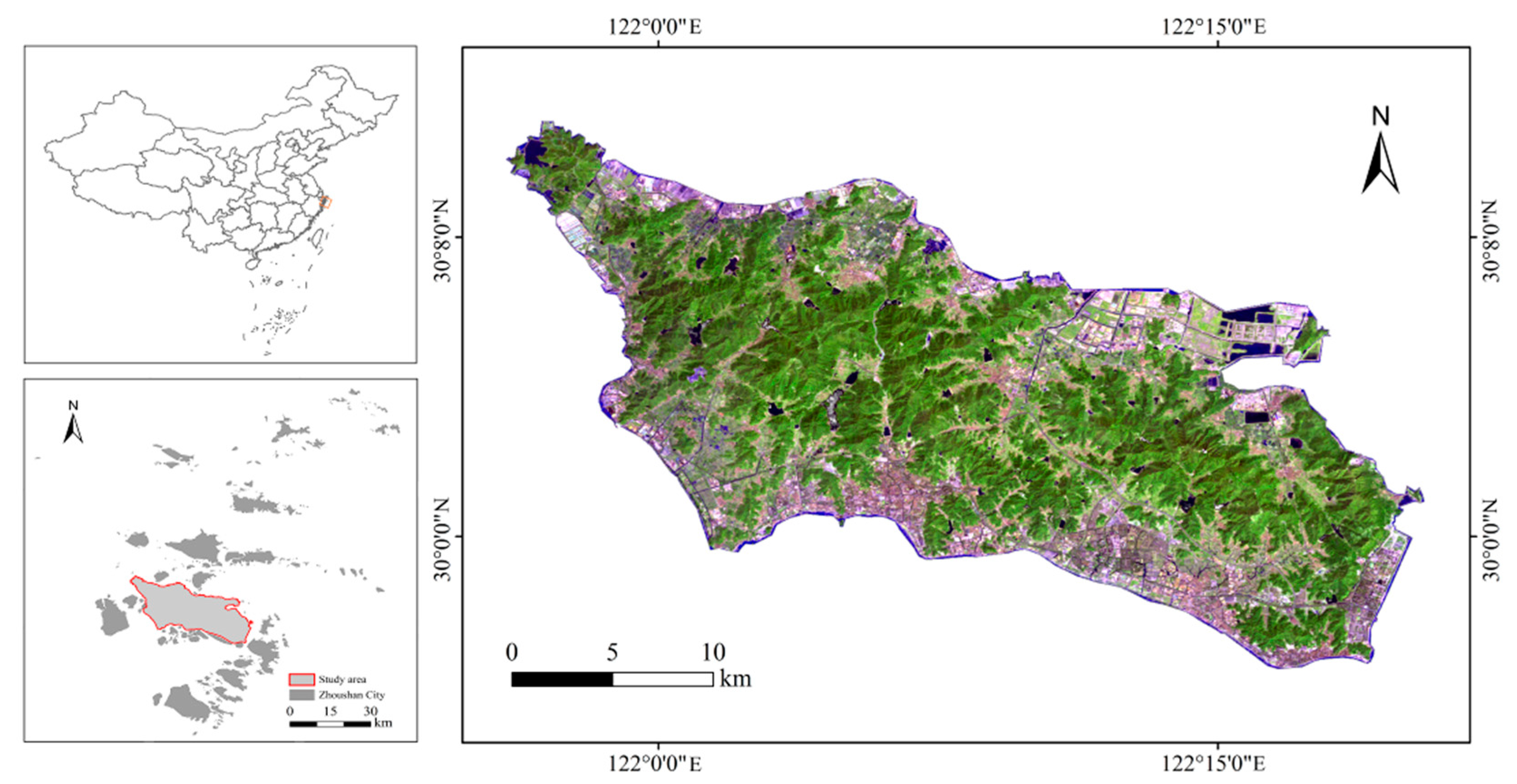

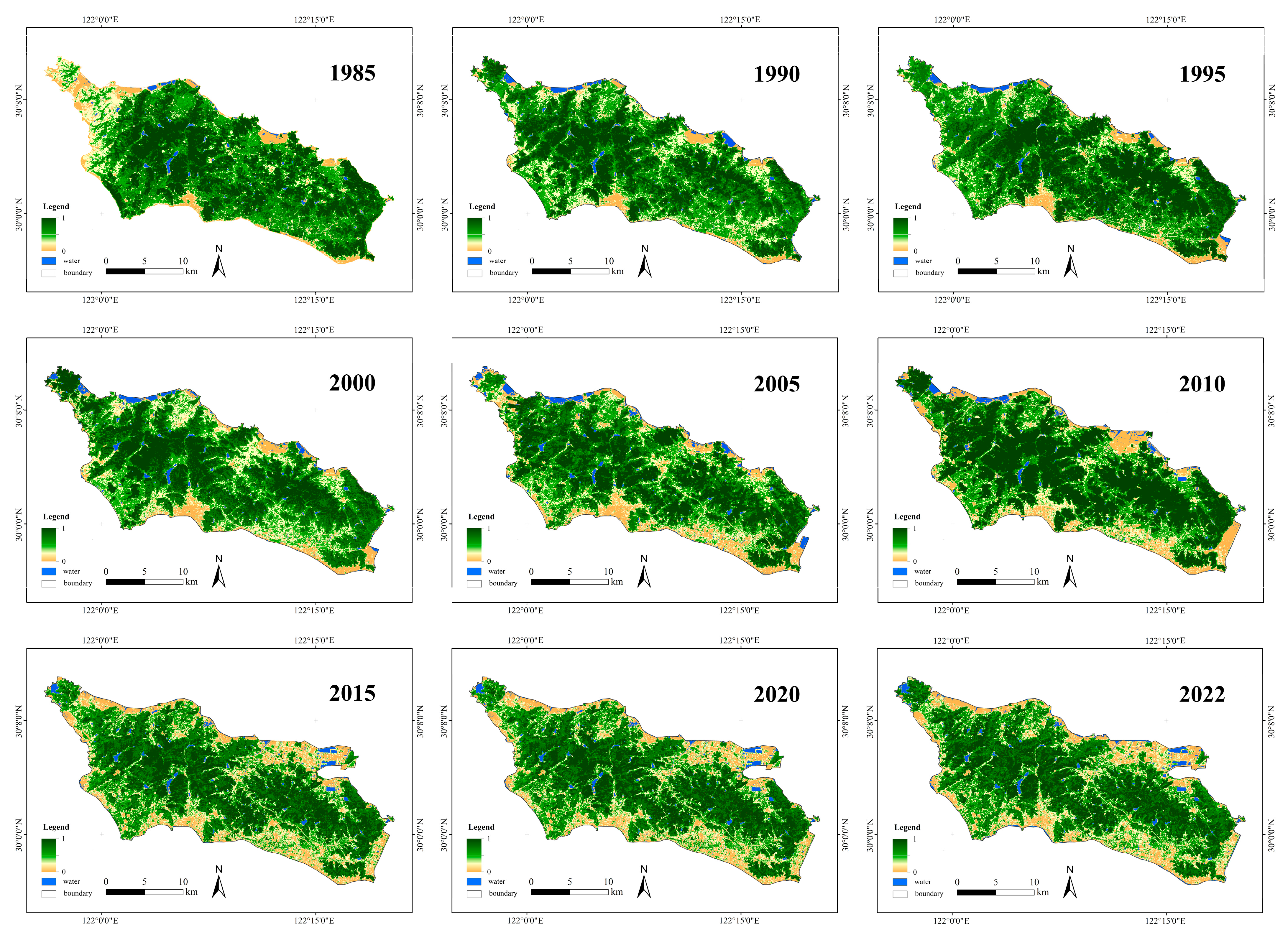

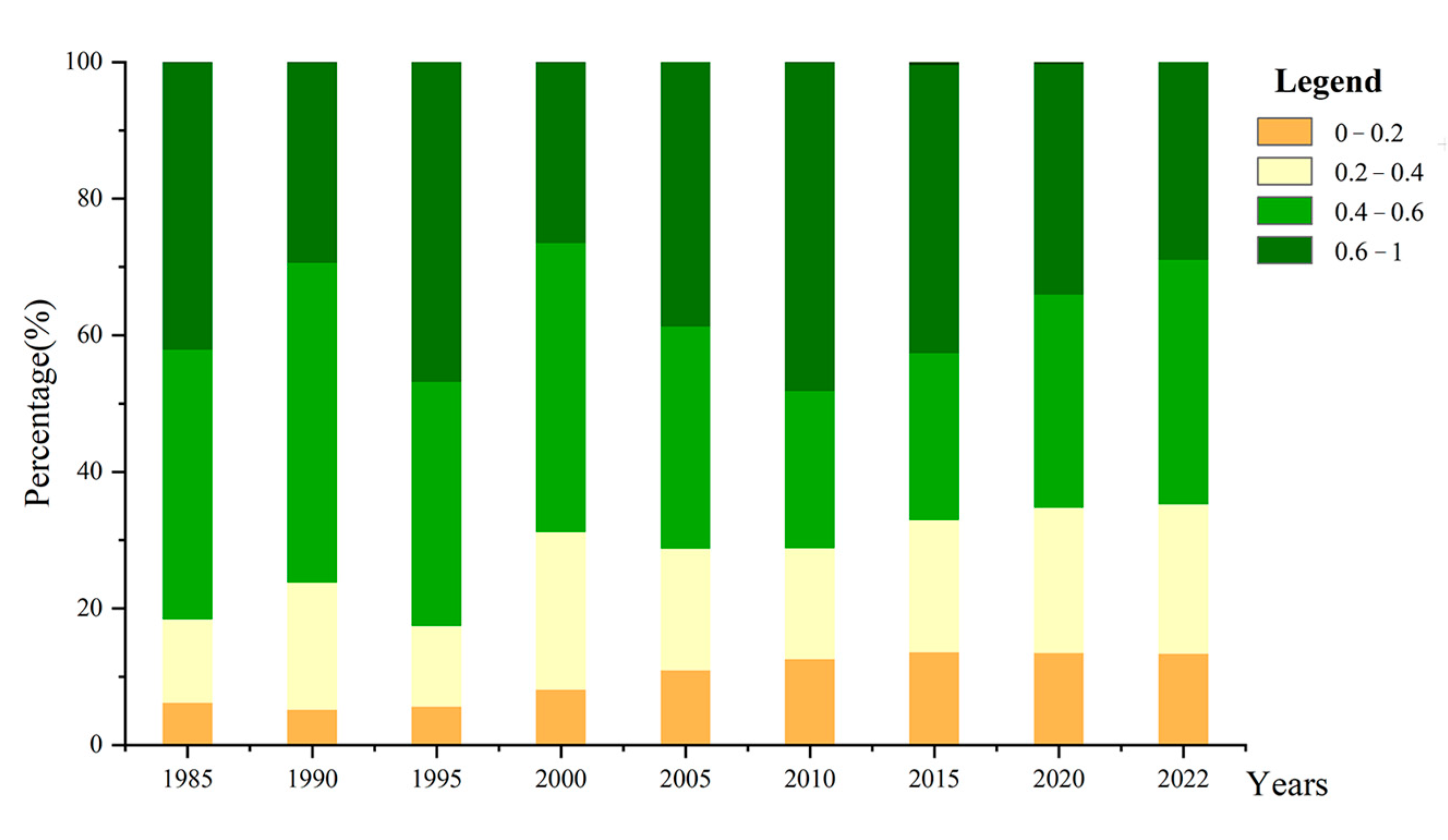


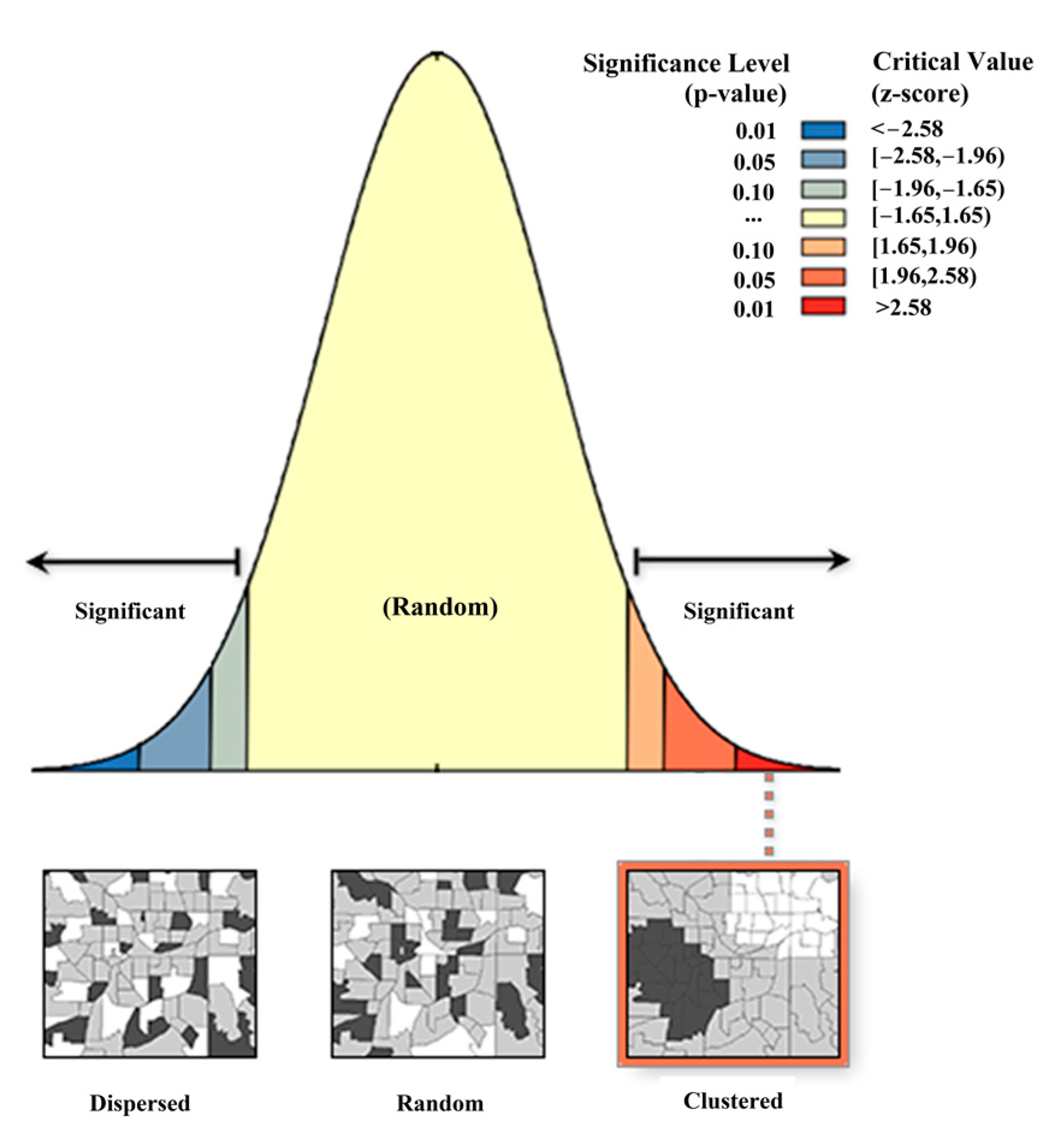

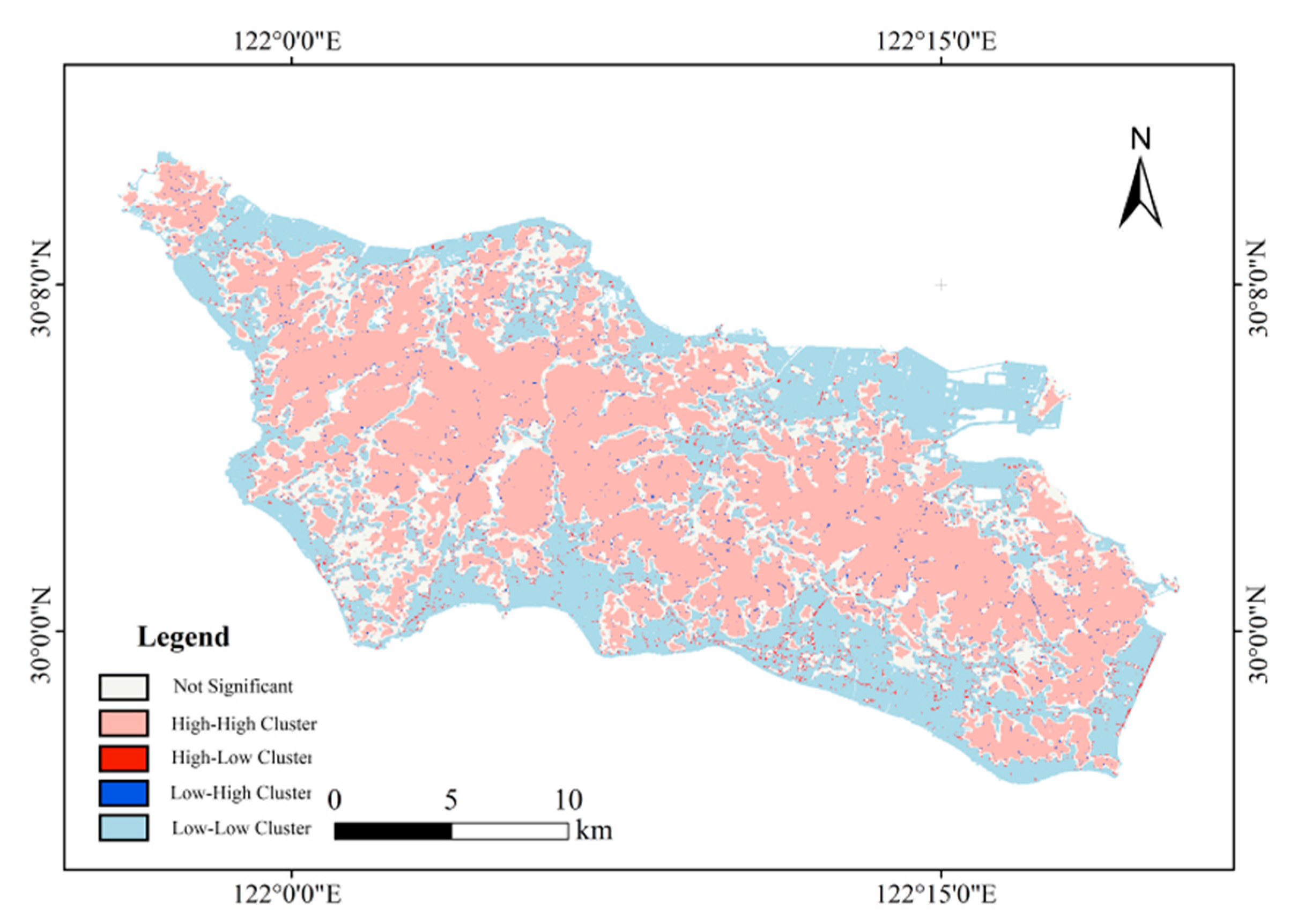
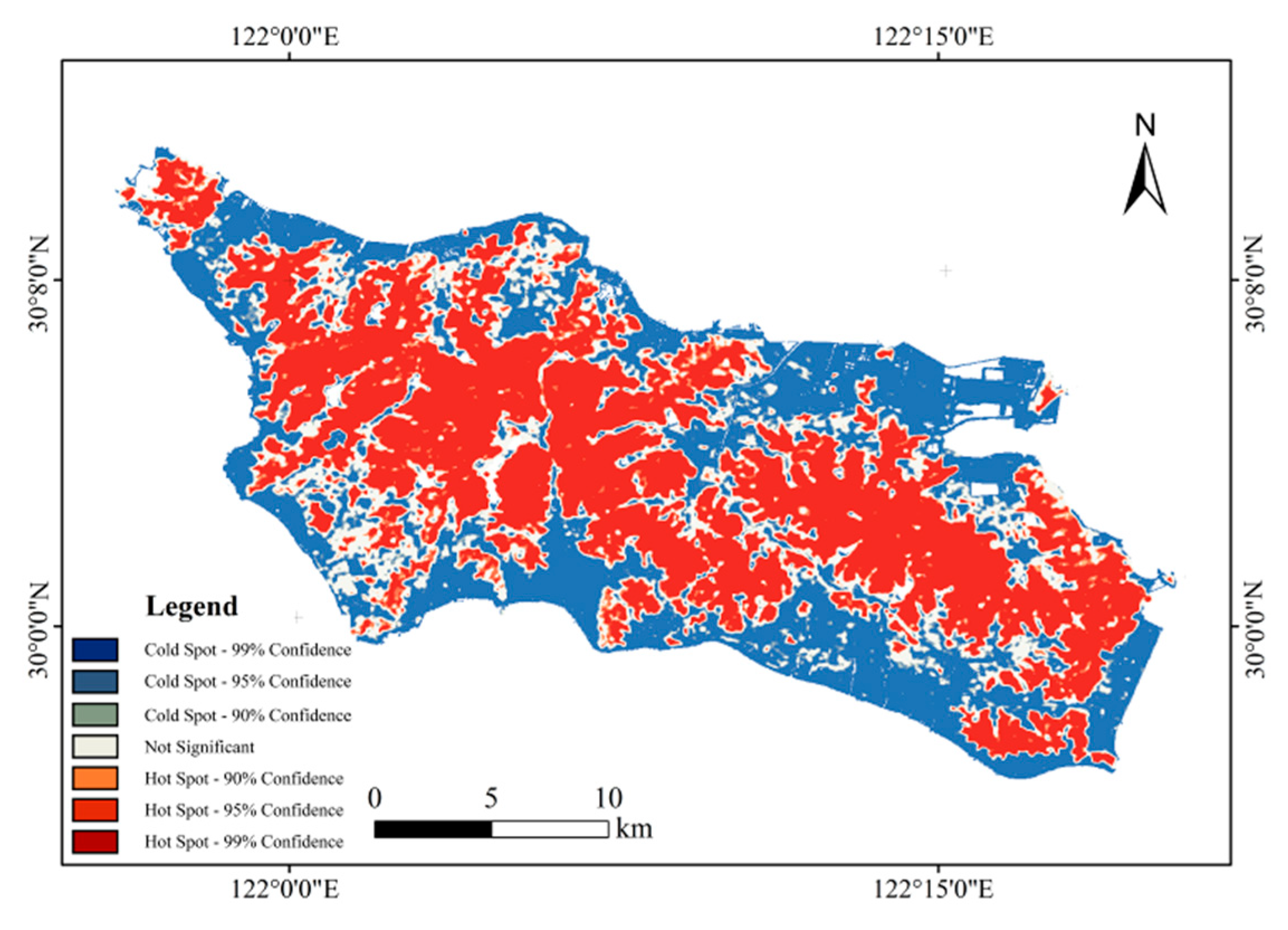
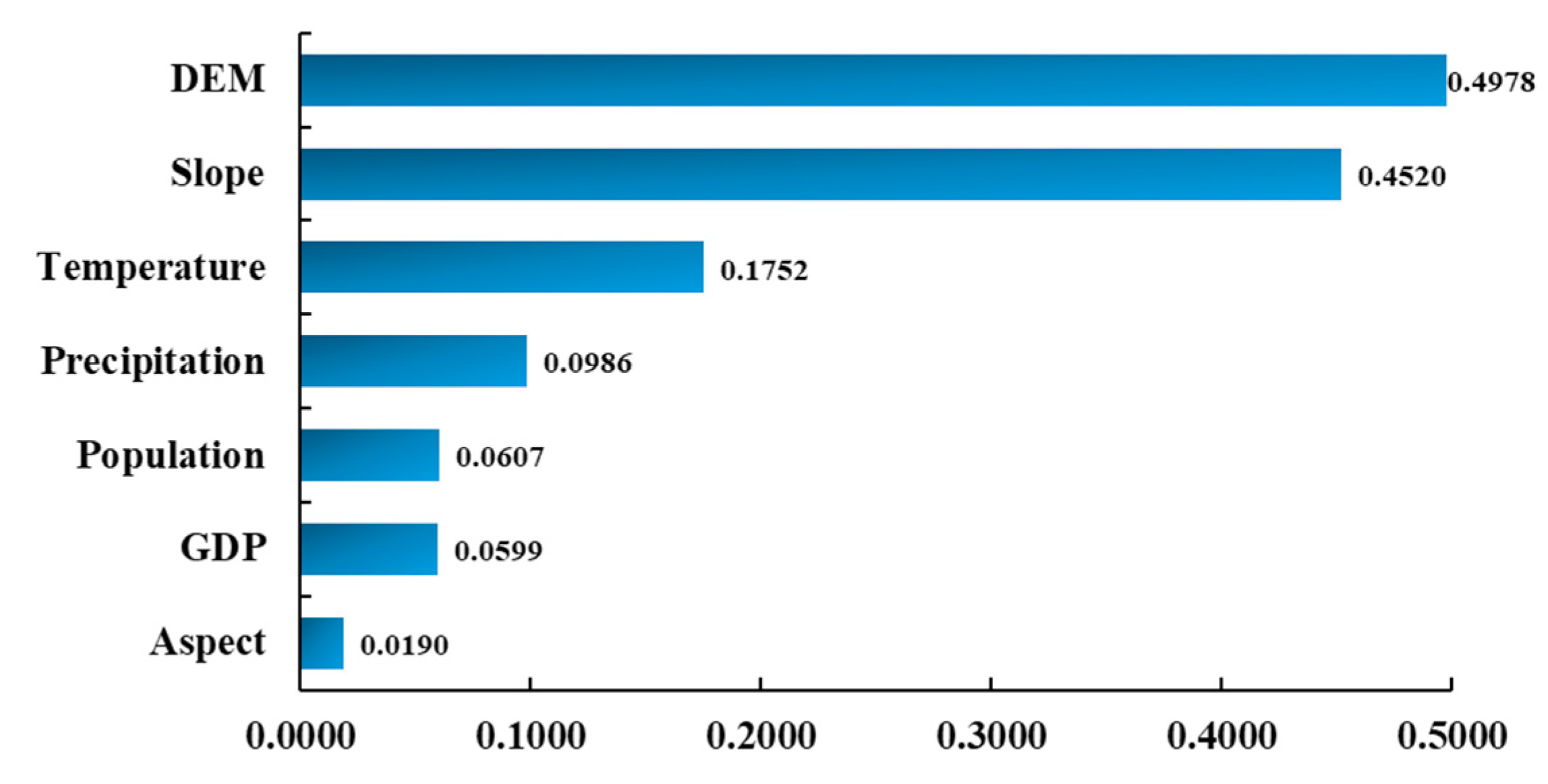
| Dataset | Satellite | Sensor | Resolution | Years |
|---|---|---|---|---|
| LANDSAT/LC08/C02/T1_L2 | Landsat 8 | Operational Land Imager | 30 m | 2022 |
| LANDSAT/LC08/C01/T1_SR | Landsat 8 | Operational Land Imager | 30 m | 2015, 2020 |
| LANDSAT/LT05/C01/T1_SR | Landsat 5 | Thematic Mapper | 30 m | 1985, 1990, 1995, 2000, 2005, 2010 |
| Category | Data | Dataset | Data Sources | Years |
|---|---|---|---|---|
| Topographical Factors | DEM | NASA/NASADEM_HGT/001 | NASA JPL | 2020 |
| Slope | NASA/NASADEM_HGT/001 | NASA JPL | 2020 | |
| Aspect | NASA/NASADEM_HGT/001 | NASA JPL | 2020 | |
| Climatic Factors | Temperature | MODIS/006/MOD11A1 | NASA | 2015 |
| Precipitation | UCSB-CHG/CHIRPS/DAILY | UCSD | 2015 | |
| Anthropogenic Factors | Population | WorldPop/GP/100m/pop/CHN_2015 | https://www.worldpop.org (15 May 2023) | 2015 |
| GDP | Kilometer grid dataset of China’s historical GDP spatial distribution | National Tibetan Plateau Data Center | 2015 |
| Low Vegetation Area (0–0.2) | Medium Vegetation Area (0.2–0.4) | High Vegetation Area (0.4–0.6) | Extremely High Vegetation Area (0.6–1) | |
|---|---|---|---|---|
| 1985 | 28.84 | 57.57 | 185.32 | 197.96 |
| 1990 | 23.89 | 86.92 | 218.63 | 137.48 |
| 1995 | 26.13 | 55.61 | 168.20 | 219.81 |
| 2000 | 38.07 | 108.32 | 199.13 | 124.74 |
| 2005 | 51.19 | 83.35 | 152.54 | 181.56 |
| 2010 | 60.85 | 78.94 | 112.16 | 234.27 |
| 2015 | 67.77 | 96.42 | 122.02 | 210.66 |
| 2020 | 67.74 | 107.20 | 157.38 | 170.17 |
| 2022 | 67.29 | 110.69 | 180.78 | 146.32 |
| Years | 1985 | 1990 | 1995 | 2000 | 2005 | 2010 | 2015 | 2020 | 2022 |
|---|---|---|---|---|---|---|---|---|---|
| Mean NDVI value | 0.53 | 0.50 | 0.49 | 0.47 | 0.44 | 0.47 | 0.49 | 0.47 | 0.46 |
| 2022 | Low Vegetation Area (0–0.2) | Medium Vegetation Area (0.2–0.4) | High Vegetation Area (0.4–0.6) | Extremely High Vegetation Area (0.6–1) | |
|---|---|---|---|---|---|
| 1985 | |||||
| Low vegetation area (0–0.2) | 14.38 | 9.69 | 3.00 | 0.21 | |
| Medium vegetation area (0.2–0.4) | 9.19 | 20.05 | 19.64 | 7.91 | |
| High vegetation area (0.4–0.6) | 18.08 | 56.99 | 71.79 | 36.90 | |
| Extremely high vegetation area (0.4–0.6) | 3.50 | 10.10 | 83.10 | 101.17 | |
| Moran’s I Index | Expectation Index | Variance | z-Value | p-Value |
|---|---|---|---|---|
| 0.6302 | −0.0714 | 0.0263 | 4.3270 | 0.0000 |
| General G Observation | General G Expectation | Variance | z-Value | p-Value |
|---|---|---|---|---|
| 0.0033 | 0.0017 | 0.0000 | 3.9462 | 0.0001 |
| Temperature | Precipitation | DEM | Slope | Aspect | Population | GDP | |
|---|---|---|---|---|---|---|---|
| Temperature | |||||||
| Precipitation | N | ||||||
| DEM | Y | Y | |||||
| Slope | Y | Y | N | ||||
| Aspect | N | N | N | N | |||
| Population | N | N | N | N | Y | ||
| GDP | N | N | N | N | Y | N |
| Temperature | Precipitation | DEM | Slope | Aspect | Population | GDP | ||
|---|---|---|---|---|---|---|---|---|
| Temperature | 0.1752 |  | ||||||
| Precipitation | 0.2644 | 0.0986 | ||||||
| DEM | 0.5174 | 0.5100 | 0.4978 | |||||
| Slope | 0.4736 | 0.4767 | 0.5435 | 0.4520 | ||||
| Aspect | 0.1886 | 0.1189 | 0.5098 | 0.4642 | 0.0190 | |||
| Population | 0.1984 | 0.1613 | 0.5167 | 0.4750 | 0.0822 | 0.0607 | ||
| GDP | 0.1862 | 0.1531 | 0.5108 | 0.4653 | 0.0796 | 0.0992 | 0.0599 |
Disclaimer/Publisher’s Note: The statements, opinions and data contained in all publications are solely those of the individual author(s) and contributor(s) and not of MDPI and/or the editor(s). MDPI and/or the editor(s) disclaim responsibility for any injury to people or property resulting from any ideas, methods, instructions or products referred to in the content. |
© 2023 by the authors. Licensee MDPI, Basel, Switzerland. This article is an open access article distributed under the terms and conditions of the Creative Commons Attribution (CC BY) license (https://creativecommons.org/licenses/by/4.0/).
Share and Cite
Liu, Z.; Chen, Y.; Chen, C. Analysis of the Spatiotemporal Characteristics and Influencing Factors of the NDVI Based on the GEE Cloud Platform and Landsat Images. Remote Sens. 2023, 15, 4980. https://doi.org/10.3390/rs15204980
Liu Z, Chen Y, Chen C. Analysis of the Spatiotemporal Characteristics and Influencing Factors of the NDVI Based on the GEE Cloud Platform and Landsat Images. Remote Sensing. 2023; 15(20):4980. https://doi.org/10.3390/rs15204980
Chicago/Turabian StyleLiu, Zhisong, Yankun Chen, and Chao Chen. 2023. "Analysis of the Spatiotemporal Characteristics and Influencing Factors of the NDVI Based on the GEE Cloud Platform and Landsat Images" Remote Sensing 15, no. 20: 4980. https://doi.org/10.3390/rs15204980
APA StyleLiu, Z., Chen, Y., & Chen, C. (2023). Analysis of the Spatiotemporal Characteristics and Influencing Factors of the NDVI Based on the GEE Cloud Platform and Landsat Images. Remote Sensing, 15(20), 4980. https://doi.org/10.3390/rs15204980






